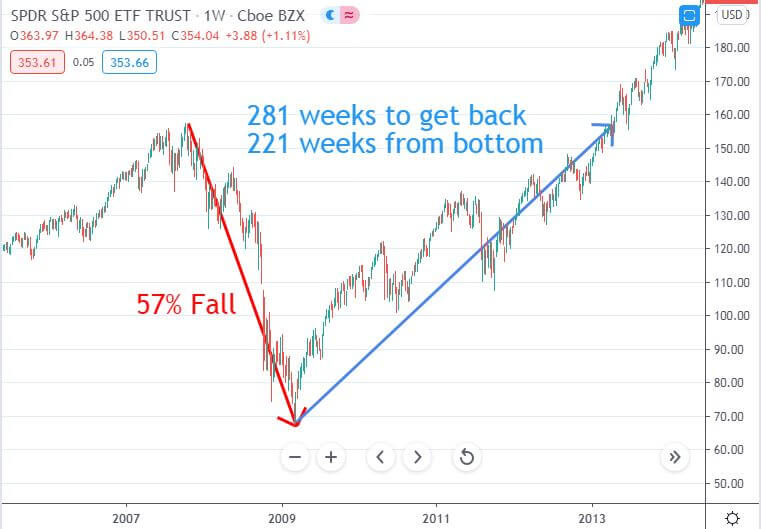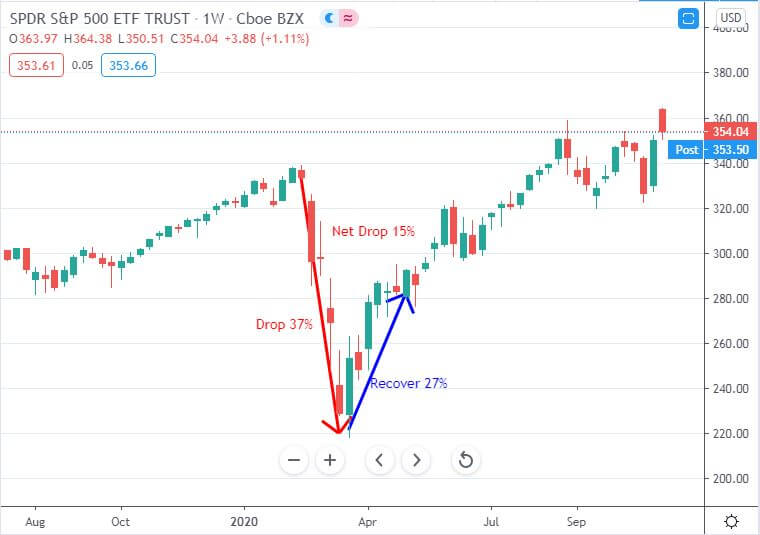Income Strategies Using Options
Introduction: Income Strategies Using Options
This blog post is a departure from my normal internet marketing stuff as it is a blog post about income strategies using options. It has been a while since I wrote an investing blog. The reasons for that will become clear as you read on – March 2, 2020 it was.

I was invited to speak at a New Opportunities Expo covering investing and forex trading opportunities. My chosen topic is income strategies using options. Now I have been running income strategies using options since 2016. The covid-19 induced market correction in February/March 2020 presented an opportunity to scale up the way I was using options to drive income. The expo organiser, Paul Botterill of Actions to Wealth, was keen to hear about how I made changes in approach when markets changed in March – as traders and investors we need to move when the markets move.
I made a video for the expo which goes through the context of the change, the strategies of covered calls and naked puts, risk factors and getting started. Check out the video – it went live on November 21.
I have written down what is in the video below – watch the video once and come back to the words to make your notes from.
Strategy for Corrections
Corrections like these are a good time to step back and learn from the lessons of the past. I certainly did that. Since I have been an investor, I have lived through two big stock market crashes – in 2000 and in 2008. When the correction happened around February 21, 2020, I knew what to do differently from 2008 and 2000. 2008 lessons: First a chart of the S&P 500 (top 500 US stocks) shows the market dropping by 57% from the 2008 peak to the low in March 2009.

The recovery peak to peak was 281 weeks = more than 5 years and 221 weeks from the bottom (4 years). If I had held onto the portfolio, it would have taken 4 years to get back to the start of the drop. Now my portfolios were outsourced (mostly) and it took 4 years longer to recover. Why? Well fund managers are required to keep portfolios in balance. Some stocks fell harder than others which made the smaller fallers become a disproportionate share – they were sold in the re-balance and the losses were locked in.
Now to 2020 – same chart of S&P 500

Through February 21, 2020 (options expiry day) US markets dropped 37% in 5 ugly days. I knew what to do.
Stop looking at the portfolio and prices and switch off the news – no more Bloomberg TV, no more CNBC. It has stayed off since then – now 9 months.
I did feel that this was a different sort of correction compared with 2008 which was all predicated on a big structural problem in the quality of sub-prime debt. 2020 felt all about sentiment and fear. Yes, it was also driven by expectations of a huge drop in consumer spending. The good news in 2020 is that the central banks and governments around the world had also learned from 2008 – intervene with monetary and fiscal stimulus quickly which is what they did. As we look back now we see that the recovery back to prior levels was a little over 6 months. My core strategy worked – do nothing and wait for the recovery.
Changes in Income Strategies Using Options
February 21 was options expiry day. I had a slate of covered calls expire that Friday and the new week was time to review portfolios and to set up new covered calls. Let’s step back and look at covered calls as a strategy.
Covered Calls
Covered calls are the key leg of income strategies using options. The idea is one sells an out-the-money call option (i.e, with strike price higher than the current price) with one month to expiry aiming for a 1% premium. That is a tidy way to juice up returns on stocks one is holding. If price stays below the sold price, you get to keep the premium and can write again the next month. If price goes through the sold strike price at expiry, you have to deliver the stock. You can buy back the contract – I seldom do that. The conventional thinking is to apply the strategy to stocks that are moving sideways.
My process is a little different – I look at all my stocks – not just the sideways ones. I set a target price move of 5% for stocks in profit and 10% for stocks not in profit. I write calls and take whatever premium I can get. I modify the target price move for stocks with higher volatility to 7.5% and 15% respectively. Example sectors of higher volatility are technology, lithium and cannabis. My thinking overall is if a stock is prepared to move 5% or 10% in a month, I am happy to take the exit then. Of course, I can replace the stock if I am keen to hold on (or buy back the sold contract). It is cheaper, in the long run, to buy the stock again and keep going rather than taking the loss on the buy back
I sat down in the last week of February 2020 and noticed that for the same 5% and 10% targets I could have got premiums ranging between 3 to 5%. This is because there was a huge spike in implied volatility. What is implied volatility you ask? It is the relationship in the price movement of the option compared to the underlying instrument.
I could easily have chosen to stick with the same process as before. However, my experience is that markets do tend to fall faster than they like to rise. That would suggest sticking with the same process – yes it has dropped 37% but will it rise 10% in a month? My other observation about corrections is markets do tend to overreact – then in a few days they see that they did that and they claw some back.
I figured that this claw back was a strong possibility. So I widened the price targets. I would look for to 10% for stocks in profit and 20% for stocks in loss. If the market was prepared to give me an exit point 20% higher than the current price inside a month, that was a better place than re-balancing right there. The other thing I did was to widen the net of stocks I was prepared to write covered calls on.
The net result is net premium has averaged out a little higher than the 1% a month I was getting previously but the income opportunity is now more fully exploited. Yes, I have had to deliver some stock along the way and sometimes at a loss. The good news is those losses are at a 20% higher exit point than previously would have been the case and I have banked 1% a month along the way. A few of the stocks I have chosen to replace – e.g., some German banks and a few solar stocks and a few lithium stocks. These have different premises and the same premise. I believe long term that I should be holding all those stocks. The German government will not allow its two big banks to fail. The climate change agenda will keep driving solar stocks and lithium stocks past the current over-supply market conditions. We just have to see how solar stocks have responded to a surging Democrat vote in the recent US elections.
Covered call writing works as a low risk strategy when one is confident that stock prices are going sideways or rising moderately. There is a risk in the strategy if prices are falling in that one could be caught holding the stock when one should have sold.
Naked Puts
There is an alternative way to run an income strategy when stock prices are going sideways or rising moderately. The strategy is to sell an out-the-money put contract (i.e., the sold strike price is lower than the current price) on a stock you would be happy to buy at a lower price than the current price. The beauty about this strategy is you do not have to hold the stock – you only have to be prepared to buy the stock if price drops below the sold strike. You do need to have enough margin in the account to make the purchase if you have to.
Now the astute reader would see an opportunity here. If you believe that a stock is going sideways or only rising moderately you can write a covered call and write a naked put on the same stock and double up the income potential. I started to do that on a few stocks – say set a price move up of 10% and a price move down of 5% and collect whatever premium I could get on both sides. Now this does introduce a calamity risk to the portfolio if there is a steep drop in prices. You lose on the stock you are holding (if you are forced to sell) and you have to buy the stock on the naked put at a much higher price than the market. Example – you would not want to be holding naked puts on Boeing (BA) through the Covid-19 saga destroying airline travel adding pain to the already painful 737 Max crash impact.
Naked Puts on Fast Risers
Now there is one other general arena to think about writing naked puts and that is to write puts on stocks that you would like to own but you think the price is too high. Good examples are TV streaming service Roku (ROKU) or Amazon (AMZN) or Tesla (TSLA). Basically what I do is pick a strike price 10 to 15 or even 25% below the current price and sell a naked put at that strike with one month to expiry. This also works really well with stocks that would be too expensive to buy a 100 shares – example Walmart (WMT) at $145. To buy 100 shares would need $14,500 in capital to be able to write a covered call. How about selling a naked put at $135 and collecting 1% premium that way? This provides a better return than say buying 10 shares and just holding for the capital growth and dividend opportunity.
Risk Factors Reminder
I will remind you of the risk factor here of major market correction or earnings related correction – price gets smashed and you are forced to buy the stock or worse buy back the sold contract. Of course, you can mitigate those situations by averaging down around the lower price. The smart risk strategy is to limit the number of naked puts open well inside the cash and/or margin capacity in the account. Also be sure you would want to own the stock for the long term even if it drops 20% from current levels.
Last small idea (not in the video) I have been using as part of my hedging strategies is I own gold (GLD) and gold mining (GDX) ETF positions. Take GDX as an example as it has a lowish price ($38 vs $177 for GLD). To hedge my portfolio, I hold a few hundred shares of GDX (up to 5% in gold). I then write a covered call against a strike price for a 10% move up (gold is volatile when it moves) and a naked put for a 5% move down in price. If the broader market gets happy overall and gold falls I will be adding to my hedging position 5% lower than the current price. If the markets gets unhappy I have 10% leeway to go before I have to close out my hedge. And I collect 2% premium each month (1% on either side) on an instrument that has a very low dividend payout (GDX does pay dividends of 0.5% pa – GLD does not)
Getting Started
If you have an existing portfolio, it is easy to get started.
- Open a low cost brokerage account to access the markets you want to trade options. I focus on US and
Germany as options markets are liquid enough. Trading costs in the US are low but high in Europe. They are
a factor to consider – I just pay them as the income feels like free money – it is not free as they do add
an element of risk to the portfolio. - Transfer the stock you want to write calls on to that account – the broker needs access to deliver stock if they have to
- Define your strategy and process (what stocks and what target price move and target premium)
- Begin – rinse and repeat each month.
If you do not have a portfolio, you can use this as a forcing device to get started.
- Open a low cost brokerage account to access the markets you want to buy stock and to trade options.
- Fund the account with enough funds to buy your first parcel of shares
- Buy your first parcel of shares (100 shares minimum). The best way to start a portfolio is to start with an index linked ETF. Choose one that has a low enough price and has a decent options market. Now it might take too much capital to buy 100 shares of an S&P 500 ETF (SPY or IVV or VOO). Idea then would be to find a cheaper index (say Europe – VGK) or a sub index you would want to start with (say Industrials – XLI) or even a single stock maybe in a strong sector (say cybersecurity – FireEye (FEYE)) or as a hedge trade (say gold mining GDX).
- Define your strategy and process (what stocks and what target price move and target premium)
- Begin – rinse and repeat each month.
- Add your next stock when you have enough capital – keep diversifying.
Managing Risk
Risk factors are important. Holding stock brings the risk of capital loss if prices fall hard. Only write covered calls against stock you are happy to hold even if price falls. You can manage the risk – by closing out the call contract and selling the stock. Your broker will only allow you to sell the stock without closing the covered call if you have a margin account.
Naked put exposure gets ugly if prices fall hard. You can manage the risk by buying back the put and taking the loss or by averaging down below the sold put strike price. The important risk strategy is to only write naked puts on stock you would be happy to own over the long term. Do it on only a few positions.
Resources
Brokerage Accounts: Interactive Brokers runs a low cost brokerage with access to most markets worldwide. They also are regulated in a wide range of markets including Australia. They do offer a referral scheme where they will award 1 Welcome IBKR share per $100 deposit up to a maximum of $1,000 worth. There are restrictions on sale and account holding period. The scheme is not available to residents of Canada and Japan and some other jurisdictions. Referring account holder (me) does not receive a benefit – just you. Invite is by email – send me an email requesting an invitation before you open your account.
New Opportunities Expo: Actions to Wealth is a Singapore based forex trading education company. Their vision is to create profitable traders and help people achieve financial freedom through trading. They ran a New Opportunities Expo on the weekend of November 21 and 22. Actions to Wealth offer excellent trading coruses – including watching traders live in action. Get help with your trading here







2 Responses
[…] on all my investing activity. Find them under teh Investing Blogs tab. I did write up a post on Income Strategies Using Options a few weeks […]
[…] March 2021 – I stayed away from the markets = not a lot to report. You can read about that in Income Strategies using Options where I went through my rationale for staying […]